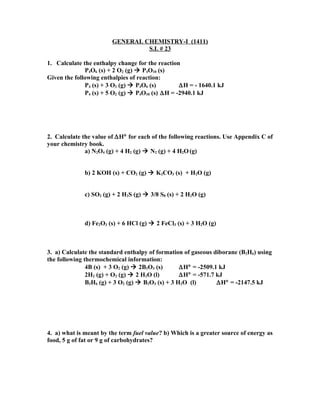
#23
- 1. GENERAL CHEMISTRY-I (1411) S.I. # 23 1. Calculate the enthalpy change for the reaction P4O6 (s) + 2 O2 (g) P4O10 (s) Given the following enthalpies of reaction: P4 (s) + 3 O2 (g) P4O6 (s) ∆H = - 1640.1 kJ P4 (s) + 5 O2 (g) P4O10 (s) ∆H = -2940.1 kJ 2. Calculate the value of ∆H° for each of the following reactions. Use Appendix C of your chemistry book. a) N2O4 (g) + 4 H2 (g) N2 (g) + 4 H2O (g) b) 2 KOH (s) + CO2 (g) K2CO3 (s) + H2O (g) c) SO2 (g) + 2 H2S (g) 3/8 S8 (s) + 2 H2O (g) d) Fe2O3 (s) + 6 HCl (g) 2 FeCl3 (s) + 3 H2O (g) 3. a) Calculate the standard enthalpy of formation of gaseous diborane (B2H6) using the following thermochemical information: 4B (s) + 3 O2 (g) 2B2O3 (s) ∆H° = -2509.1 kJ 2H2 (g) + O2 (g) 2 H2O (l) ∆H° = -571.7 kJ B2H6 (g) + 3 O2 (g) B2O3 (s) + 3 H2O (l) ∆H° = -2147.5 kJ 4. a) what is meant by the term fuel value? b) Which is a greater source of energy as food, 5 g of fat or 9 g of carbohydrates?
- 2. 5. The heat of combustion of ethanol, C2H5OH (l) is -1367 kJ/mol. A batch of wine contains 10.6% ethanol by mass. Assuming the density of the wine to be 1.0g/mL, what caloric content does the alcohol (ethanol) in a 6-oz glass of wine (177 mL) have? 6. a) Why are fats well suited for energy storage in the human body? b) A particular chip snack food is composed of 12% protein, 14% fat, and the rest carbohydrate. What percentage of the calorie content of this food is fat? c) How many grams of protein provide the same fuel value as 25g of fat? 7. Write balanced equations that describe the formation of the following compounds from their elements in their standard states, and use Appendix C to obtain the values of their standard enthalpies of formation: a) HBr (g), b) AgNO3 (s), c) Hg2Cl2 (s), d) C2H5OH (l). 8. Suppose that the gas-phase reaction 2NO (g) + O2 (g) 2 NO2 (g), were carried out in a constant –volume container at constant temperature. Would the measured heat change represent ∆H or ∆E? If there is a difference, which quantity is larger for this reaction? Explain.